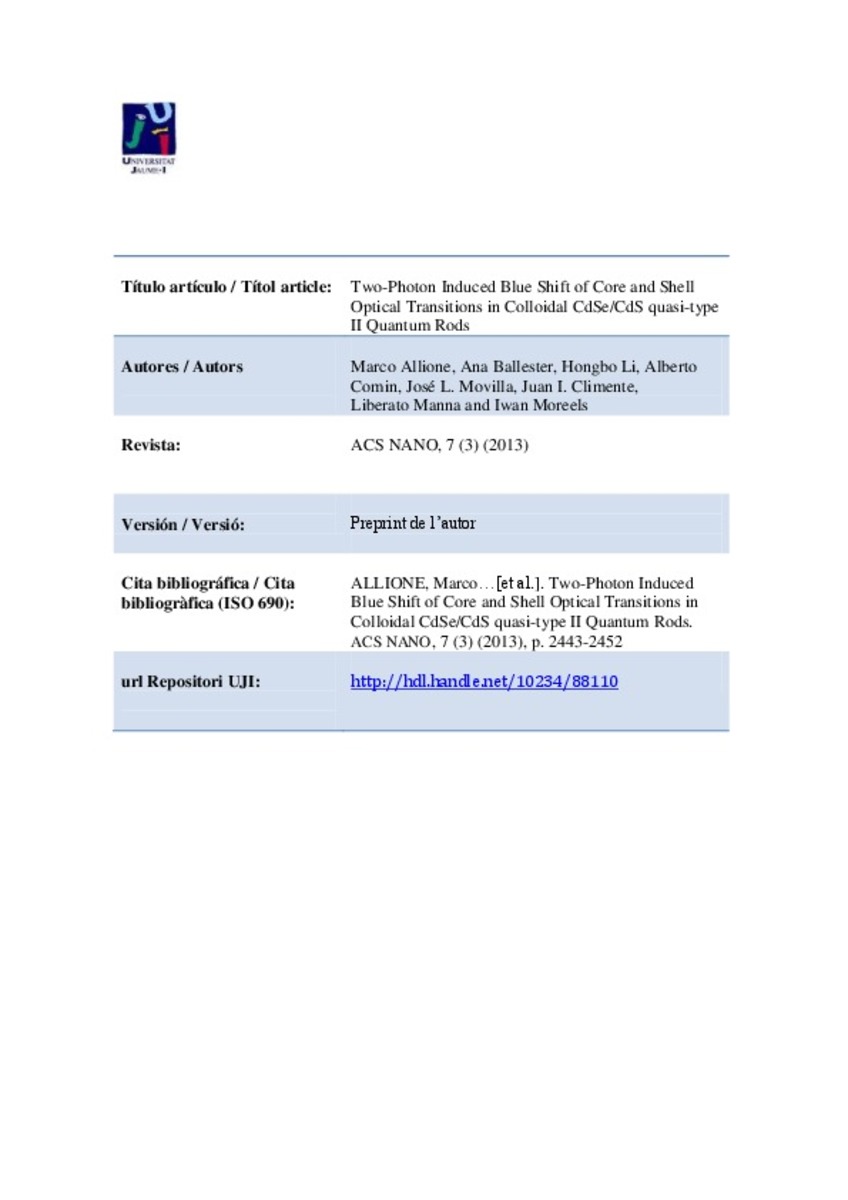Mostrar el registro sencillo del ítem
Two-Photon Induced Blue Shift of Core and Shell Optical Transitions in Colloidal CdSe/CdS quasi-type II Quantum Rods
| dc.contributor.author | Allione, Marco | |
| dc.contributor.author | Ballester Caudet, Ana | |
| dc.contributor.author | Li, Hongbo | |
| dc.contributor.author | Comin, Alberto | |
| dc.contributor.author | Movilla, Jose L. | |
| dc.contributor.author | Climente, Juan I. | |
| dc.contributor.author | Manna, Liberato | |
| dc.contributor.author | Moreels, Iwan | |
| dc.date.accessioned | 2014-03-21T11:24:24Z | |
| dc.date.available | 2014-03-21T11:24:24Z | |
| dc.date.issued | 2013-03 | |
| dc.identifier.citation | ACS NANO, 7(3) (2013), p. 24413-2452 | ca_CA |
| dc.identifier.uri | http://hdl.handle.net/10234/88110 | |
| dc.description.abstract | The spectral dependence of the two-photon absorption in CdSe/CdS core/shell nanocrystal heterorods has been studied via two-photon-induced luminescence excitation spectroscopy. We verified that the two-photon absorption in these samples is a purely nonlinear phenomenon, excluding the contribution from multistep linear absorption mediated by defect states. A large absorption cross section was observed for CdSe/CdS core/shell quantum rods, in the range of 105 GM (1 GM = 10–50 cm4 s phot–1), scaling with the total nanocrystal volume and thus independent of the core emission wavelength. In the two-photon luminescence excitation spectra, peaks are strongly blue-shifted with respect to the one-photon absorption peaks, for both core and shell transitions. The experimental results are confirmed by k·p calculations, which attribute the shift to both different parity selection rules that apply to one-photon and two-photon transitions and a low oscillator strength for two-photon transitions close to the ground-state one-photon absorption. In contrast with lead chalcogenide quantum dots, we found no evidence of a breakdown of the optical selection rules, despite the presence of band anisotropy, via the anisotropic hole masses, and the explicitly induced reduction of the electron wave function symmetry via the rod shape of the shell. The anisotropy does lead to an unexpected splitting of the electron P-states in the case of a large CdSe core encapsulated in a thin CdS shell. Hence, tuning of the core and shell dimensions and the concurrent transition from type I to quasi-type II carrier localization enables unprecedented control over the band-edge two-photon absorption. | ca_CA |
| dc.format.extent | 27 p. | ca_CA |
| dc.format.mimetype | application/pdf | ca_CA |
| dc.language.iso | eng | ca_CA |
| dc.publisher | American Chemical Society | ca_CA |
| dc.rights | Attribution-NonCommercial-ShareAlike 4.0 Spain | * |
| dc.rights.uri | http://creativecommons.org/licenses/by-nc-sa/4.0/ | * |
| dc.subject | II - VI nanocrystals | ca_CA |
| dc.subject | Quantum dots | ca_CA |
| dc.subject | Two-photon absorption | ca_CA |
| dc.subject | Optical selection rules | ca_CA |
| dc.subject | K.p calculations | ca_CA |
| dc.subject | Effective mass approximation | ca_CA |
| dc.title | Two-Photon Induced Blue Shift of Core and Shell Optical Transitions in Colloidal CdSe/CdS quasi-type II Quantum Rods | ca_CA |
| dc.type | info:eu-repo/semantics/article | ca_CA |
| dc.identifier.doi | http://dx.doi.org/10.1021/nn3057559 | |
| dc.rights.accessRights | info:eu-repo/semantics/openAccess | ca_CA |
| dc.relation.publisherVersion | http://pubs.acs.org/doi/ipdf/10.1021/nn3057559 | ca_CA |
| dc.type.version | info:eu-repo/semantics/publishedVersion | ca_CA |
Ficheros en el ítem
Este ítem aparece en la(s) siguiente(s) colección(ones)
-
QFA_Articles [818]
Articles de publicacions periòdiques








